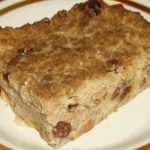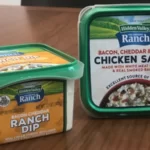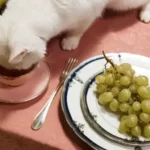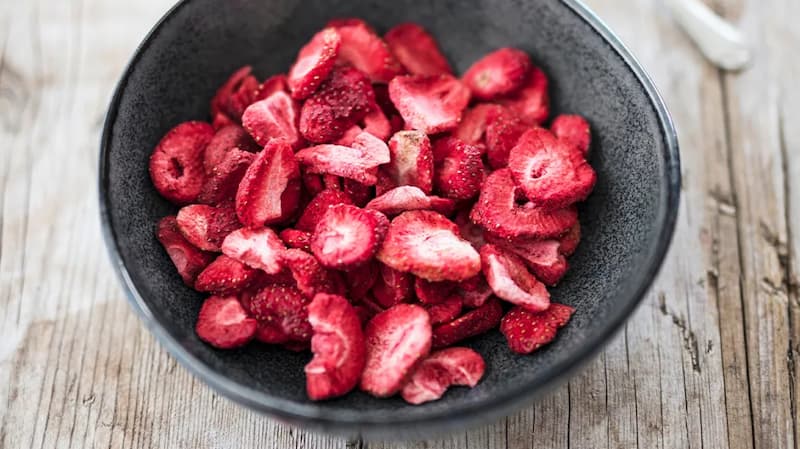
To start with, what is freeze-dried food?
Foods that have undergone the process of lyophilization, or freeze drying, which prolongs their shelf life while preserving the majority of their nutrients, are known as freeze-dried foods.
The American Institute for Cancer Research (AICR) has already provided funding for studies on the nutrient retention in freeze-dried foods, particularly freeze-dried fruits.
Commercially produced packets and tins of freeze-dried foods need to be rehydrated before consumption because freeze drying involves removing water from frozen food. Since the water has been removed, freeze-dried foods are light and practical for travel, especially long-term storage as emergency supplies.
For more specific information, keep reading.
Table of Contents
What Is Freeze-drying And Freeze-dried Food?
Did you ever as a child consume astronaut ice cream? That is ice cream that has been dried using freezing temperatures.
In its most basic form, freeze-drying, also known as lyophilization, is a procedure that involves freezing a product to remove moisture, which is then sublimated by a vacuum to produce a product that is almost entirely dry.
Let’s now explore a little more deeply!
Food, pharmaceuticals, and biochemistry are the industries that use this method of moisture removal most frequently. This relatively new technology allows solids which contain moisture or liquids that contain some solid matter to be dried almost to the point that zero moisture remains. An example of a solid which contains moisture would be like an apple (or any other solid food), while an example of a moisture that contains some solid matter would be like a tomato sauce!
In a very specific order, the following steps make up the freeze-drying process:
- In a freeze-dryer, trays are used to hold raw or cooked food.
- Between -30F and -50F is the temperature at which the appliance freezes the food. At a very low temperature, the food must be completely frozen.
- Once the food has been frozen, the appliance creates a vacuum while gradually raising its internal temperature.
- This combination allows a chemical process called sublimation to occur. (Since high school chemistry, you’ve probably forgotten about sublimation.)
- The machine starts a drying cycle as the food’s moisture leaves it and continues until a specific vacuum pressure and food dryness are reached.
- To make sure the food is completely dried, there are two more drying cycles after the initial one.
So even after reading the technical explanation, you may still be wondering, “Okay, but what does that really mean?” Despite the fact that there are only six steps involved.?’
Examine sublimation once more and the significance of this.
Without ever passing through a liquid phase, sublimation is the process by which solids transform into gas. Dry ice used to create a spooky fog for Halloween is a typical illustration of this. This means that for our food, the ice turns into vapor rather than water! In fact, the procedure is pretty cool! And because any water that is not frozen solid at a very low temperature will not convert immediately into vapor, the freezing step is crucial because it will prevent liquid water from forming instead. Dehydration, a very different drying process, results as a result. To find out how long food needs to be frozen for this sublimation process to happen, we’ve experimented for months and run countless cycles.
Food that has been freeze-dried has a unique appearance and texture thanks to the sublimation process! Food that has been freeze-dried and non-freeze-dried alike in appearance. The ability to visually distinguish the various food ingredients when one opens a Bushka’s Kitchen pouch frequently astounds people. Both apples and brussel sprouts appear to be the same thing.
The texture of freeze-dried food is very airy and crunchy as a result of how the moisture is taken out of the food. The reason why freeze-dried food rehydrates so well is due to this. The freeze-dried food is so porous and eager to absorb moisture that when you add hot water, the food almost immediately absorbs it and takes on a nearly identical appearance. Dehydrated food and freeze-dried food are very different from one another in this regard. While freeze-dried food is almost instantly hydrated, dehydrated food typically requires 15 to 20 minutes to fully absorb the water you add. We advise letting freeze-dried food sit for 3 minutes to allow for maximum hydration before eating.
How Are Freeze-dried Foods Made?
The process of lyophilization, which involves three main steps, is necessary before the raw materials—food appropriate for such preservation techniques—can be turned into freeze-dried foods. freezing, primary drying, and secondary drying. Although there are additional steps involved before and after these three, they are the most crucial ones for freeze drying.
There are a number of things to do before going through the three steps of freezing. The produce must first be inspected to look for any impurities. Additionally, the freshness of the produce must be verified. To prevent bulk spoilage, processing is done seasonally, in accordance with when the various produce are harvested. As with the Mountain House range, some other types of produce require cooking before freezing. Additionally, foods that will be served as freeze-dried meals must be cooked.
Freeze-dried Food Process
The success of the entire process of freeze drying depends on the completion of the freezing step, which is the first and most crucial one in the entire procedure. The food must be completely frozen before moving on to the next step, and it must be frozen below a specified critical temperature because if any portions aren’t completely frozen, the stability of the finished product may be compromised.
By using sublimation, which is the process by which a solid turns into a gas without first passing through the liquid state, the ice that formed from the frozen product during the previous process is removed during primary drying. The frozen food will have lost 95–97% of its water content during this stage of the freeze drying procedure, despite the fact that it is one of the longest.
Through the use of heat, the remaining water content of the frozen food is removed during the secondary drying process. The frozen food can have at least 99.5% of its water content removed through diffusion and desorption. The conditions for secondary drying are very different from those for primary drying; for secondary drying, the pressure in the chamber is reduced, as opposed to primary drying’s relatively high pressure.
Following the subsequent steps, the food is removed from the machine and examined to ensure that all water content has been removed and to check for any impurities that might have been mixed in with the freeze-dried food. The food is then separated and ready for packing, some of it being ground up first.
Angel food cake is one of the most delicate cakes, but can you freeze angel food cake?
Differences Between Dehydrated & Freeze-dried Food
The food’s sugars and proteins are unaltered because freeze drying takes place at low temperatures. When you add water, they will quickly rehydrate, and the food will taste pretty much the same as it did before it was freeze-dried.
The process of dehydration depends on the heat-induced evaporation of water, which also alters the food. Proteins slowly cook (or overcook if they’re already cooked), fruit sugars slowly caramelize, and the food shrinks and acquires a rubbery texture.
Dehydrated foods like dried carrots can sometimes be easily rehydrated. Other foods don’t dehydrate well and they never return to their original state.
On the other hand, freeze drying is effective for almost any food. All forms of freeze-dried food, including fruit, cheesecake, and even meat, are delectable.
Foods that are extremely high in fat or sugar and low in moisture are the only things that don’t freeze dry well. such as honey, chocolate, and peanut butter. Freeze-drying isn’t really necessary because those naturally have a long shelf life.
How Long Does Freeze-dried Food Last?
Food that is freeze-dried keeps its best quality for decades, whereas dehydrated food typically only lasts two to three years at most. Freeze-dried food should last for at least 25 and possibly 30 years when stored properly.
When I acquired a few “antique” cans of freeze-dried food at an estate sale, I had the chance to put this to the test. I cracked open the sealed No. 10 cans, the freeze-dried apple slices were absolutely delicious after 17 years in storage.
They were just as good as the day they were preserved, and I rehydrated them to make an apple pie that duped my husband. It would have been challenging to distinguish the freeze-dried version in a blind taste test if he had believed that I had made it with fresh apples.
The Pros Of Freeze-dried Food
Any food product can be freeze-dried using this technique, including ice creams.) … People who engage in outdoor activities (such as backpacking, mountain biking, sailing, kayaking, self-sufficient running, and trail running) or who simply want to be prepared and have a food source for use in survival situations use these products.
The following are the rationales for using freeze-dried goods:
Taste and appearance : freeze-dried products taste and look like fresh products. Food products are similar to their fresh counterparts after being rehydrated; freeze drying doesn’t shrink or harden the food; instead, it preserves its flavor, shape, and aroma.
Shelf life : freeze-dried products have a very long shelf life. Food can last between 15 and 25 years when it is stored properly. Even after this time, products will still be safe to eat and retain their original flavor and nutritional value. Food that has been dehydrated and frozen can only be stored for two years.
Nutrition values : freeze drying causes only little damage to food. About 95% of the nutrients in freeze-dried foods are retained during the freezing and drying process. Due to the heat used during the process, which breaks down some of the food’s vitamins and minerals, other techniques, like dehydration, only retain 60% of the nutritional value.
Weight and space : once the water is removed from the foods, they become very light. For instance, more than 80% of vegetables, fruits, and dairy products contain water; cooked pasta contains about 70% water; between 65 and 70% of fish and meat; and a small amount of water is present in some products, such as butter. Furthermore, freeze drying takes up very little space, allowing you to carry multiple units in your backpack or store more food in your storage area.
Preparation : freeze-dried meals prepare easy and quickly, all you need to do is add hot or cold water depending on the menu, wait a few minutes and ‘voila’… your food is ready for eating ! There is a wide selection of freeze-dried meals available today thanks to manufacturers. Everything can be freeze-dried, from breakfast to dessert. You can now enjoy eating nutritious and varied meals even in the open sea or on top of a mountain thanks to the freeze-drying process, which ranges from aligot to paella and beyond scrambled eggs and apple sauce.
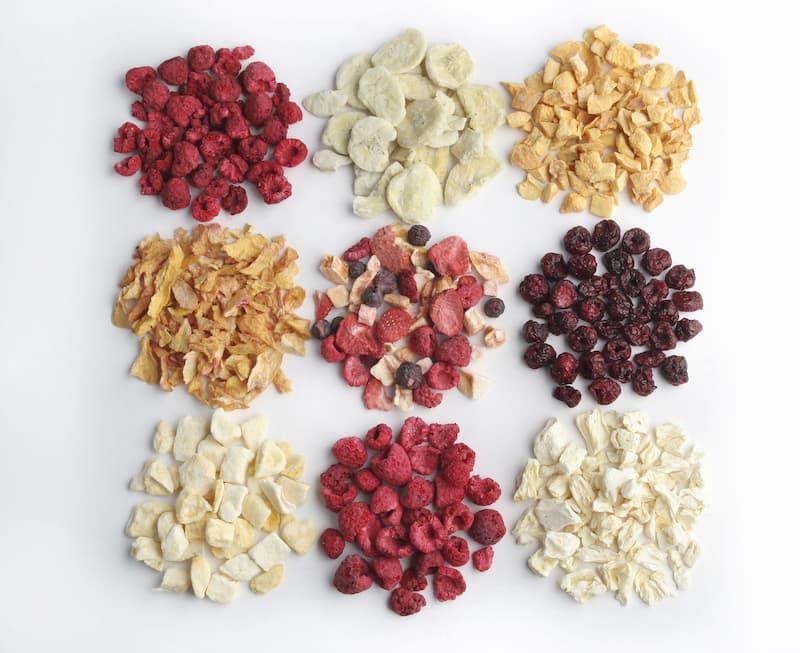
The Cons Of Freeze-dried Food
The cost of freeze-dried foods is their most noticeable drawback. freeze-dried foods can range in price, depending on the meal, from £4 for a single serving pouch to £15 for a pouch good for four, and from £32 to £42 for a #10 can. This is because the processing required to produce them.
Additionally, because the dimensions of freeze-dried foods are almost identical to those of fresh foods, another drawback of some freeze-dried food varieties is that they take up some space. This space is, admittedly, less than that required by their fresh counterparts.
Market For Freeze-dried Foods
As freeze-dried foods can typically be stored unopened at room temperature for more than 25 years and have been tested to even long timeframes when stored in cooler environments, the market for them has grown over the years from being utilized as space food to camping stock and stockpiled in case of emergency. See more about What Is Freeze Dried Dog Food?
Are Frozen And Freeze-dried Meats The Same?
They are totally different, though, so no. Although there is a freezing step involved in the process of making freeze-dried food, the finished product is not frozen. Food that has been frozen has a shorter shelf life and must be kept, well, frozen. Food that has been freeze-dried is completely shelf stable and has a long shelf life!
Is Freeze-dried Food Healthy?
Ice cream is ice cream, after all, so it depends on what you’re eating! Food that has been freeze-dried and regular food are essentially the same. It’s simply devoid of moisture.
Despite the fact that there hasn’t been much research done specifically on freeze-drying technology, it has been found that food that has been dried in this way has a similar flavor, color, texture, and nutritional profile to food that hasn’t been frozen, with the exception of water-soluble vitamins, which lose some of their nutritional value. When comparing freeze-dried to other preserved food, freeze-dried food most closely matches fresh food.
The nutrition profile is essentially unchanged, with the exception of a few vitamins. Thus, it has the same number of calories, sodium, sugars, and other nutrients as its fresh counterpart! Don’t eat a bag of freeze-dried strawberries all at once, then! Even though it doesn’t seem like you are eating much, you are still taking in the same number of calories as if those were real strawberries!
Where Can I Get Freeze-dried Food?
I advise trying freeze-dried food first if you’ve never done so out of curiosity before attempting to make your own. At least where it’s kept in our neighborhood stores, freeze-dried food can occasionally be found in the grocery store next to the dehydrated fruit. Since commercially produced freeze-dried food is only as good as the ingredients that go into it, I’ve actually found the quality to be quite variable.
It will turn out that way if you freeze-dry underripe or flavorless fruit. I conducted a blind taste test with my children to determine which freeze-dried food was the best, and Valley Food Storage consistently won. They could always recognize the freeze-dried fruit from Valley Food Storage.
If you’re interested, I conducted a thorough analysis of the top emergency food suppliers in 2021, after the market turmoil of 2020 had a significant impact. For convenience, flavor, and long shelf life, nearly all of them produce freeze-dried food. Even though the freeze-drying procedure is the same for all foods, some are significantly superior to others.
Quality matters whether you freeze-dry food at home or buy it already made and dried. The outcome depends on how well-prepared the food is before it is put into the freeze-drying machine.
How Is A Freeze Dryer Constructed?
Actually building a home freeze dryer is honestly easier than you think, provided you’re incredibly handy with tools. The drying chamber is incredibly tiny, and operating it costs a lot (lots of dry ice).
It works well for scientific applications where you are freeze-drying a small quantity of something for an experiment, but it is hardly worthwhile to put in 24 hours of labor and use a cartload of dry ice to get a cup of freeze-dried strawberries.
If you’re interested in learning more, you can watch this video, which uses inexpensive parts that you can buy online for about $300, to describe the procedure in detail.
There are actually several DIY freeze dryer tutorials available online, and they all operate according to the same general idea.
- Small Vacuum Chamber Method: This method has a smaller batch size but is easier to set up.
- Pressure Canner Vacuum Chambers: You can get a little bit more space by using pressure canner bodies as vacuum chambers, but they cost about $400 each, plus a vacuum pump. If you can’t find used pressure canners for less than $1,000 (which is difficult to do), the cost of building this system will be well over $1,000.
- I’ll admit that this large volume freeze dryer is quite powerful and has a large capacity. You could make something similar to this with a welder, condenser, and a lot of stainless steel. Although it’s a remarkable DIY accomplishment, you’ll need a lot of supplies, tools, and technical know-how to complete the task. If you don’t already have a fully functional welding shop, the overall cost will be at least $2,000 for the metal, machinery, and tools.
They build a cold chamber to condense liquid, and then they put the frozen food in a different chamber. For 24 to 36 hours, keep the two connected with a vacuum pump and everything chilled with dry ice.
Since the vacuum pump is running for a long time, this method consumes a lot of electricity. To keep everything cold the entire time, it also takes a lot of dry ice and manual attention.
Electricity costs per batch are probably between $1 and $2, and dry ice costs between $10 and $20. The issue is that all of these custom systems have incredibly small batch sides. Even the largest ones can only successfully freeze-dry one or two cups of food. (Unless you spend several thousand dollars to weld together a sizable stainless steel chamber like they do in the previous video I linked.)
When you consider all the manual operation time and per batch costs, their $300 to $2,000 price range means that they are not actually a cost-saving option. However, it’s undoubtedly a fun party trick and a fantastic way to teach science to homeschoolers (or to impress your friends).
Providing you can do it safely and avoid setting the place on fire or burning anyone with dry ice.
Using A Home Freeze Dryer
If you’ve read this far, you probably already have a good idea of how freeze-drying operates. The freeze dryers for your home that you buy are actually quite similar to the ones made at home that are demonstrated in the aforementioned videos.
They are all combined into a single, elegant device that resembles a washing machine but is actually a freezing chamber with an incredibly effective low temperature condenser that rapidly chills food. After that, a vacuum pump lowers the pressure in the chamber and draws the water away from the food.
To start, you load the food onto trays and choose the cycle. You will be asked to choose whether you prefrozen the food before adding it, whether it is a liquid (like milk or eggs), or a solid (like fruit, vegetables, meat, or cheese).
After the cycle completes, sensors will check the moisture content of the food and turn the machine off automatically.
Pretty sleek, right?
Home freeze dryers are self-contained units that are incredibly effective, but they are also expensive. The smallest unit costs just over $2000, and the most expensive model costs about $3,500.
History Of Freeze Drying
The Incas used the principles of freeze drying to store their crops, which dates back to the beginning of recorded history. Food crops are kept at high altitudes, particularly in the Andes, where freezing temperatures cause the crops to become frozen and low air pressure causes the water to slowly evaporate from the crops. Moving forward to World War II, it is said that blood plasma and penicillin were freeze-dried to make them easier to transport. Years later, freeze drying-based innovations continue to grow, including those for pharmaceuticals, food preservation, and pet preservation. Maxwell House’s freeze-dried coffee is thought to be the first food to be produced in a commercial setting.
Traditional Freeze Drying Methods
In South America, specifically the Peruvian Andes, freeze-drying for food preservation has a long history. In the late autumn, when it is below freezing in the high mountains, potatoes are harvested.
The potatoes freeze if left out over night; they then dry out in the blazing high-altitude sun during the day. They have a freeze-thaw cycle similar to what we experience in Vermont during the maple sugaring season, with freezing temperatures at night and warm, sunny days in between.
The local women “dance” on the potatoes barefoot after three days of the potatoes being frozen at night and thawed during the day. This aids in pressing out moisture and removing potato peels. The potatoes are walked or danced on each day in the sunlight and naturally re-frozen at night as the freeze/thaw cycle lasts for another seven days.
The procedure takes about 10 days to complete from beginning to end. Chuño, the finished product, can be stored for many years without additional preservation. (similar to contemporary machine-processed freeze-dried food.)
FAQs
What Makes Freeze-dried Food So Expensive?
The process required to produce the final product is primarily to blame for the fact that a year’s worth of freeze-dried food costs almost twice as much as it does to store food using other techniques. Both the equipment and the operational costs are quite high. The first step, gathering the raw materials, gives an indication of the cost. To ensure that the food is fresh before processing it or cooking it first and then processing it, fresh produce must be purchased.
As was already mentioned, the equipment is quite pricey, with the most affordable unit costing at least 5,000 pounds and going as high as 500,000 pounds. In addition to the machinery, the process itself is expensive. Costs for the preliminary processes could include the price of screening for bacterial content and other impurities. Costs following the drying process could also include the price of a second round of screening, the use of mills for grinding, and finally, sealing machines — not to mention the price of the actual packaging.
Why Pick Freeze-dried Foods?
Despite being pricey, freeze-dried foods are beneficial because they: shelf life, since freeze-dried foods can last longer than most food storage unrefrigerated; nutrition, as freeze-dried foods retain most of the nutrient content than others; varieties, as there are so many options to choose from; and finally, weight, as the process done for freeze-dried foods leaves the final product lightweight and perfect for campers.
Why Are Freeze-dried Foods Less Expensive In The Us?
The United States of America’s policies on food production and consumption in comparison to those of other countries may be one of the reasons why freeze-dried foods are more affordable here. Compared to the US, which has no such ban in its territories, the food ban in Europe, for instance, may slightly raise the cost of purchasing produce.
The currency’s purchasing power is another possible explanation. The US dollar might be able to buy more than, say, the Euro.
Another reason why freeze-dried foods are less expensive in the US than the rest of the world is that the US and Europe have established highly effective distribution and storage systems, which may speed up the process and reduce costs over time.
The End
A variety of items are freeze-dried in addition to food. This method is frequently used to preserve pharmaceutical products like antibiotics and vaccines. Frozen-drying is also used to create powders for ceramics, pigments, and specialty chemicals. The process of freeze-drying different aerosol sprays is currently being developed. One of the most intriguing uses is the freeze-drying of flowers to create bouquets that can be kept in storage for several months before being reactivated to create “fresh” flowers. For those who prefer flowers that bloom for a limited time, this would be especially helpful.
Many thanks for reading.

